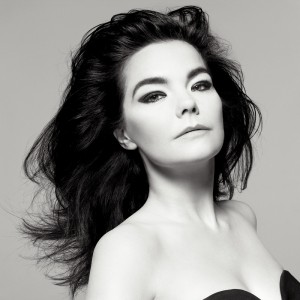By Alec Marchant
Staff Writer
The multimedia project and eighth studio album from the Icelandic queen of experimental dance-pop, Bjork, embraces innovation and creativity with open arms.
Bjork’s latest album, “Biophilia,” stays true to her character and has no qualms with expressing herself and venturing into unknown musical territories.
Bjork came into the spotlight in the ‘90s with heavy beat-based material and anything but ordinary public behavior. Seven albums, two children and one swan dress later, Bjork began work on her newest album: 10 songs that correspond to their own individual iPad apps titled “Biophilia.” Bjork covers a wide range of earthy topics with this new album.
However, this album has a different feel than previous ones. More mature and less defined, “Biophilia” has a murky atmospheric discomfort that gives the album a very raw and personal ambience.
Bjork uses her standout voice more mysteriously, catching the listener’s attention with small and layered sounds. She then expands that same sound into a cacophony of magic with the bouncing and beating of bass and synth. All these components combine to create something unheard before.
Opening up with “Moon,” a lullaby-like track which comments on the moon’s cycles, Bjork gives a crystal clear image of what is to come on the rest of the tracks. Ominous tones, sharp noises, and erratic voice fluctuations are foreshadowed the moment Bjork capriciously uses her unusual voice to enhance the simplicity of her melody in the song’s chorus.
With the obvious standout tracks “Crystalline” and “Mutual Core,” she experiments with different musical styles such as drum and bass, a capella and all the pseudo pop worldly overtones that have always been associated with Bjork. She uses her Icelandic mystique to her advantage for this album and allows it to transpose into the music, creating a more invited rhythm.
Bjork has created her own instruments to further her unique sound. One of them, called the Sharpsichord, a gigantic circular rotating harp, uses 11,520 pins and needles on a giant spinning wheel to create a stringy noise. The Sharpsichord is one more reason to extol Bjork and praise her inexplicable immunity to failure.
Three of the 10 iPad apps, “Virus,” “Crystalline” and “Moon,” have been released, allowing an up-close look into the life and musical background of Bjork. She and her close team of artists and thinkers have created something beautiful: interactive editions of the songs containing essays, games, art and instruments.
Points of creativity, innovation, talent and design all touched, “Biophilia” is a masterpiece. Bjork has done it again, taking such simple everyday occurrences and transferring them into beautiful melodies. “Biophilia,” while not everybody’s cup-of-tea, gives hope to a seemingly decaying period for music, that artists, no matter their age, can bring something new to the table.
“Biophilia” was released on Oct. 10 and is available on iTunes and stores nationwide. “Biophilia” apps are available on the Apple App Store.


Leave a Reply